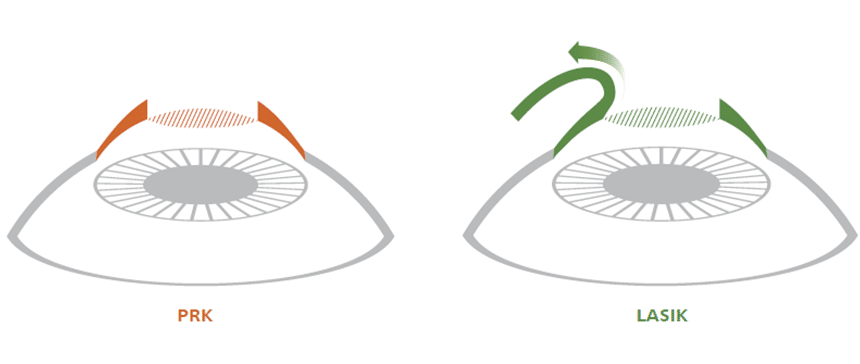Our pursuit of ideal eyesight frequently prompts us to have eye surgery. Modern eye operations like Photorefractive keratectomy (PRK) and Laser-Assisted In Situ Keratomileusis (LASIK) are commonplace for those with eye disorders. The purpose of this article is to compare and contrast these two widely used surgical techniques, emphasising their variations, procedures, expenses, and things to think about while choosing between LASIK and PRK.
Understanding Different Types of Eye Surgery
Contents
LASIK is a type of refractive surgery where an excimer laser is used to reshape the cornea which will improve vision problems such as myopia (nearsightedness), hyperopia (farsightedness, and astigmatism. This procedure is popular due to its quick recovery time and the minimal discomfort that will be felt by the patients.

PRK, on the other hand, is a type of refractive surgery that also uses an excimer laser to reshape the cornea and it is the precursor to LASIK. However, the relevance of PRK applies to those who may have thinner corneas or dry eyes who are not ideal candidates for LASIK.
Between LASIK and PRK, there are particular differences when it comes to their recovery times and preparatory requirements. With that, LASIK offers quicker recovery than PRK but PRK will have a greater availability to a wider array of patients.
What does LASIK involve?
LASIK involves the use of a microkeratome or femtosecond laser to create a thin hinged tissue flap on the cornea. The surgeon then folds back the flap, revealing the underlying corneal tissue. An excimer laser ablates the exposed tissue, thereby reshaping the cornea and correcting the refractive error. The surgeon then repositions the flap, which adheres naturally without the need for stitches.
Immediately after the procedure, patients will experience significant vision improvements and will be able to return to their regular routine just the day after the surgery. Often, there will be minimal discomfort during and after the procedure which is due to the numbing eye drops the patients receive.
What does PRK involve?
In PRK, the surgeon removes the entire outer layer, or epithelium, of the cornea prior to reshaping the underlying corneal tissue with an excimer laser. Unlike LASIK, there’s no flap created or repositioned. The epithelium naturally regrows after surgery, fitting snugly over the reshaped cornea.
The recovery time for PRK is generally longer than for LASIK. Patients may need three to five days for the epithelium to regenerate and up to three months (or more) for their vision to fully stabilize. However, the final visual outcome of PRK is comparable to that of LASIK.
The Cost of the Eye Surgery
The cost of the eye surgeries of LASIK and PRK differ from each other and may contribute to your decision as to which one you will choose. The average cost of LASIK in the United States is between US $2,000 to $4,000 per eye but can increase to US $5,000,

The cost of PRK eye in the United States is similar to LASIK in the sense that it will range around US $2,000 to $3,000 per eye but it can also increase up to possibly US $5,000 as well just like LASIK.
One more thing to keep in mind though is that these procedures are more often than not covered by insurance. This means that on top of paying things out of your pocket, you will have to also consider the follow-up costs, care costs, or even the cost of botched procedures which is fortunately very rare.
Lasik vs PRK: Deciding which surgery is right for you
Choosing between getting a LASIK or PRK procedure done can be a decision that is based on a variety of factors in accordance with your cornea thickness, lifestyle, and your career as well. With that, it is important to have a detailed discussion with your eye care professional where you will weigh the advantages and disadvantages of each procedure.

For LASIK, you will find that there is generally a faster recovery for this procedure in which there is also the use of anaesthetic eye drops where there will be less discomfort during and after the procedure. On the other hand, there is PRK which is aimed at a wider variety of patients where their eye conditions like dry eye or thinner corneas may make them ineligible for LASIK. At the same time due to the lack of a corneal flap, the risk of flap-related complications.
Despite differences, both procedures aim to correct the vision of people suffering from certain eye problems and both procedures have high rates of satisfaction amongst patients. Both procedures have their risks but it is also important to remember that it is by a low margin in which there is a much greater rate of success.

In the end, both LASIK and PRK are very effective and currently common methods of vision correction that both have their own specific procedure steps, recovery times, and costs. When you are deciding between the procedures, you need to understand the aspects that encompass the procedures and yourself.
With that, You will find it very beneficial to discuss the process with an eye care professional who will help you determine your specific eye condition and lifestyle. From that point, you will find which procedure is best for you between LASIK, PRK, or even other procedures.

Make sure to find a reputable clinic as well because dealing with an organ as vulnerable as your eye can create long-term issues that you will not be satisfied with. Whatever the case is in the end, your eye surgery should result in the satisfaction that you have for your vision because that is what we will need to see the beautiful environment around us.

